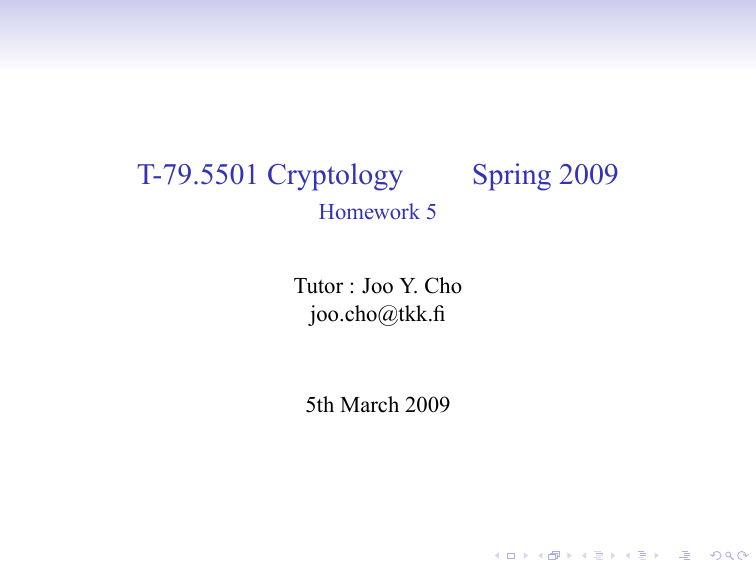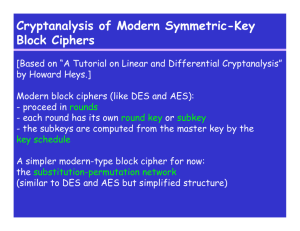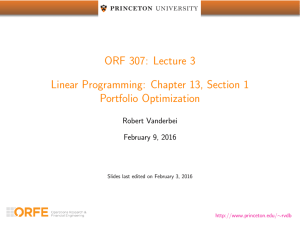T-79.5501 Cryptology Spring 2009
advertisement

T-79.5501 Cryptology
Homework 5
Tutor : Joo Y. Cho
joo.cho@tkk.fi
5th March 2009
Spring 2009
Q1. Using the Berlekamp-Massey Algorithm find an LFSR that
generates the sequence:
0 0 0 1 1 1 0 0 .
Compare your solution with the polynomial found in HW4.
Lk+1 = max{Lk , k + 1 − Lk }
f k+1 (x) = xLk+1 −Lk f k (x) + xLk+1 −k+m−Lm f m (x)
Running the Berlekamp-Massey algorithm we get:
k zk−1 Lk f (k)
observing zk
2
0
0 1
3
0
0 1
z3 = 1 (the first nonzero term), set
L4 = 4 and f (4) (x) = x4 + 1
4
4
1
4 x +1
does not work for z4 = 1, change:
L5 = max{4, 5−4} = 4 and f (5) =
x0 (x4 + 1) + x4−4+3 · 1
4
3
5
1
4 x +x +1
OK for z5 = 1, no changes
6
1
4 x4 + x3 + 1
does not work for z6 = 0, change:
L7 = max{4, 7−4} = 4 and f (7) =
x0 (x4 + x3 + 1) + x4−6+3 · 1
4
3
7
0
4 x + x + x + 1 OK for z7 = 0, no changes
8
0
4 x4 + x3 + x + 1 no more sequence
Q2. Consider the 4-bit to 4-bit permutation πS defined as follows:
0 1 2 3 4 5 6 7 8 9 A B C D E F
3 F 0 6 A 1 D 8 9 4 5 B C 7 2 E
(This is the fourth row of the DES S-box S4 .) Denote by
(x1 , x2 , x3 , x4 ) and by (y1 , y2 , y3 , y4 ) the input bits and output bits
respectively. Find the output bit yj for which the bias of
x1 ⊕ x2 ⊕ x3 ⊕ x4 ⊕ yj is the largest.
x1 x2 x3
0 0 0
0 0 0
0 0 1
0 0 1
0 1 0
0 1 0
0 1 1
0 1 1
1 0 0
1 0 0
1 0 1
1 0 1
1 1 0
1 1 0
1 1 1
1 1 1
number ni
bias value
x4
0
1
0
1
0
1
0
1
0
1
0
1
0
1
0
1
S1
3
15
0
6
10
1
13
8
9
4
5
11
12
7
2
14
y1
0
1
0
0
1
0
1
1
1
0
0
1
1
0
0
1
10
1
8
y2
0
1
0
1
0
0
1
0
0
1
1
0
1
1
0
1
4
− 41
y3
1
1
0
1
1
0
0
0
0
0
0
1
0
1
1
1
10
1
8
y4
1
1
0
0
0
1
1
0
1
0
1
1
0
1
0
0
8
0
x1 ⊕ x2 ⊕ x3 ⊕ x4
0
1
1
0
1
0
0
1
1
0
0
1
0
1
1
0
Q3. Suppose that X1 and X2 are independent random variables which
take on values from the set {0, 1}. We use ²i to denote the bias of Xi ,
²i = Pr[Xi = 0] − 21 , for i = 1, 2. Prove that the random variables X1
and X1 ⊕ X2 are independent if and only if ²2 = 0 or ²1 = ± 21 .
A3. Claim: The random variables X1 and X1 ⊕ X2 are independent if
and only if ²2 = 0 or ²1 = ± 21 .
Suppose that X1 and X2 are independent random variables. Let ²12
denote the bias of X1 ⊕ X2 and ²112 the bias of X1 ⊕ (X1 ⊕ X2 ).
[“⇒”]
We prove that ²2 = 0 or ²1 = ± 21 if the random variables X1 and
X1 ⊕ X2 are independent. By the Piling-Up Lemma, we have
²12 = 2²1 ²2 and ²112 = 2²1 ²12 . Hence,
²112 = 2²1 2²1 ²2 = 4²21 ²2 .
Since X1 ⊕ (X1 ⊕ X2 ) = X2 , we have ²112 = ²2 , and thus
4²21 ²2 = ²2 .
This equation holds if and only if either ²2 = 0 or ²1 = ± 21 .
[⇐]
We prove that X1 and X1 ⊕ X2 are independent if ²2 = 0 or ²1 = ± 12 .
The proof makes use of the converse of the Piling-Up Lemma. Since
X1 and X2 are independent random variables, we have
(
0
if ²2 = 0,
2²1 ²12 = 4²21 ²2 =
²2
if ²1 = ± 12 .
In other words, 2²1 ²12 = ²2 if ²2 = 0 or ²1 = ± 21 . Because ²112 = ²2 ,
we get ²112 = 2²1 ²12 . By the converse of the Piling-Up Lemma, X1
and X1 ⊕ X2 are independent.
Q4. Suppose that w ∈ {0, 1}n . Show that
½
X
0, for w 6= 0
w·x
(−1) =
2n , for w = 0
n
x∈{0,1}
Hint. Determine the number of x ∈ {0, 1}n such that w · x = 0.
If w = 0, we get
X
(−1)w·x =
x∈{0,1}n
X
1 = 2n .
x∈{0,1}n
If w 6= 0, we get
X
X
X
1+
(−1) = 2n−1 − 2n−1 = 0.
(−1)w·x =
x∈{0,1}n
x : w·x=0
x : w·x=1
This is true because there is an equal amount of x ∈ {0, 1}n that
satisfy w · x = 0 and w · x = 1 for w 6= 0.
To prove the latter case more strictly, we use induction on the number
of coordinates in w = (w1 , . . . , wn ) and x = (x1 , . . . , xn ). If n = 1, we
have w = 1 6= 0, and it follows that
X
(−1)w·x = (−1)0 + (−1)1 = 0.
x∈{0,1}
Hence, the claim is true for n = 1. Suppose that the claim is true for
n = k ≥ 1. We show that the claim is true for n = k + 1. Denote
w0 = (w1 , . . . , wk ) and x0 = (x1 , . . . , xk ). Dividing the sum into
separate parts based on whether xk+1 = 0 or xk+1 = 1, we get
X
X
X
0 0
0 0
(−1)w·x =
(−1)w ·x ⊕wk+1 ·0 +
(−1)w ·x ⊕wk+1 ·1
x∈{0,1}k+1
x0 ∈{0,1}k
=
X
x0 ∈{0,1}k
0
0
(−1)w ·x +(−1)wk+1
= 0.
{z
=0
0
(−1)w ·x
0
x0 ∈{0,1}k
x0 ∈{0,1}k
|
X
}
This proves the claim for n = k + 1.
|
{z
=0
}
Q5. Consider the example linear attack in the textbook, Section 3.3.3.
For S22 replace the random variable T2 by U26 ⊕ V28 . Then in the third
round the random variable T3 is not needed. What is the final random
variable corresponding to Equation (3.3) and what is its bias?
A5.
• T0 2 = U26 ⊕ V28
• T3 is not needed. Hence, the arrows through S23 are removed.
• U26 and U414 are removed.
• The new final variable is
X5 ⊕ X7 ⊕ X8 ⊕ U48 ⊕ U416 .
• The bias of the new variable T0 2 : in the table of the S-box
(Figure 3.2) a = 0100 = 4 and b = 0001 = 1. Hence,
NL (a, b) = NL (4, 1) = 10. The bias ²02 = 10/16 − 1/2 = 1/8.
• The biases of approximation is
23−1 ²1 ²02 ²4 = 4(1/4)(1/8)(−1/4) = −1/32.
Q6.
Consider the finite field GF(23 ) = Z2 [x]/(f (x)) with polynomial
f (x) = x3 + x + 1 (see Stinson 6.4).
1. Compute the look-up table for the inversion function g : z 7→ z−1
in GF(23 ), where we set g(0) = 0.
2. Compute the algebraic normal form of the Boolean function
defined by the least significant bit of the inversion function.
A6-a. The multiplication table of the finite field
GF(23 ) = Z2 [x]/(x3 + x + 1) is given on page 253 of the textbook.
Using it we can, given a nonzero element, find another element such
that the product is equal to 1 = 001. We get:
z
z−1
000 000
001 001
010 101
011 110
100 111
101 010
110 011
111 100
A6-a. Another approach to create this function table is to express the
seven elements of the multiplicative group of Z2 [x]/(x3 + x + 1) as
powers of the element x = 010:
xk
k
0
0 x = 001
1 x = 010
2 x2 = 100
3 x3 = 011
4 x4 = 110
5 x5 = 111
6 x6 = 101
The g(z) = g(xk ) = x−k = x7−k , for all k = 0, 1, . . . 6 as the order of
the multiplicative group of Z2 [x]/(x3 + x + 1) is seven.
A6-b. Using the ANF algorithm (Lecture 6) we get
k b3 b2 b1 f (b1 , b2 , b3 )
x3 x2 x1
g(x1 , x2 , x3 )
0 0
0
0
0
0
1 0
0
1
1
x1
2 0
1
0
1
x1 ⊕ x2
3 0
1
1
0
x1 ⊕ x2
4 1
0
0
1
x1 ⊕ x2 ⊕ x3
5 1
0
1
0
x1 ⊕ x2 ⊕ x3
6 1
1
0
1
x1 ⊕ x2 ⊕ x3 ⊕ x2 x3
7 1
1
1
0
x1 ⊕ x2 ⊕ x3 ⊕ x2 x3








